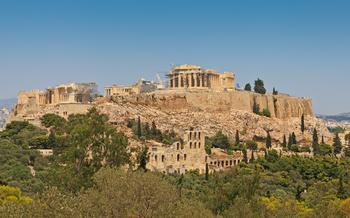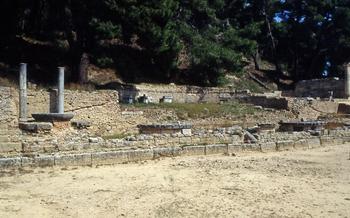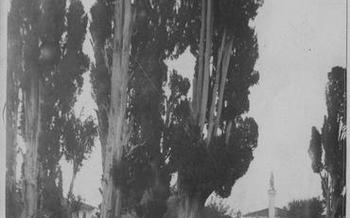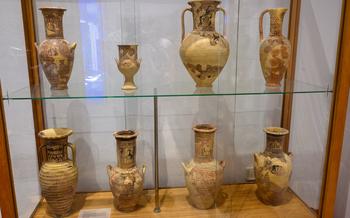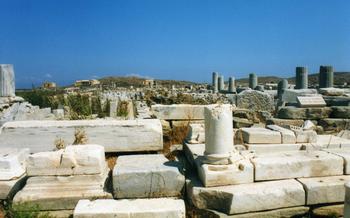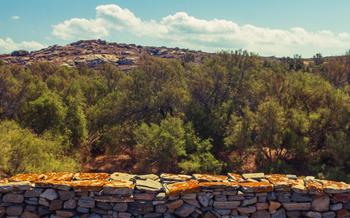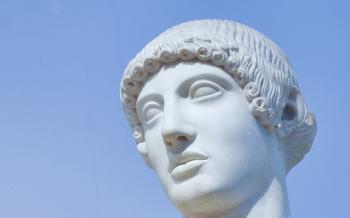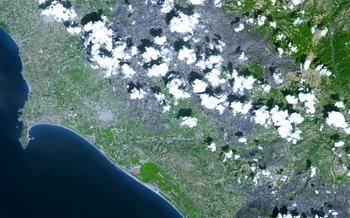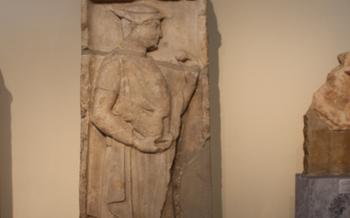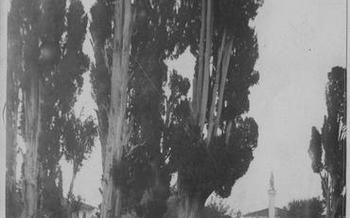
Archaeological Museum of Dion
- Dion: Antiquity Unveiled
- Stepping into the Archaeological Museum
- Historical Jewels of Dion
- Dion's Divine Protector
- Echoes of Dionysus
- Triumphal Arches: Gates to Glory
- Urban Life in Ancient Dion
- Dion's Necropolis: Eternal Resting Places
- Divine Baths and Healing Springs
- Dion's Festival of Zeus: Reviving Ancient Olympic Spirit
- Local Cuisine: A Culinary Journey
- Natural Wonders of Pieria: A Tapestry of Beauty
- Insider Tip: Hidden Gems
Dion: Antiquity Unveiled
Dion, nestled in the foothills of Mount Olympus, is a treasure trove of ancient history and culture, inviting you to delve into the captivating past of Greece. Once a flourishing city-state and a religious sanctuary, Dion holds a significant place in Greek mythology and played a pivotal role in the region's development. Archaeological excavations have unearthed remarkable artifacts, shedding light on the city's rich history and providing glimpses into the lives of its inhabitants.
Dion's strategic location at the foot of Mount Olympus, the mythical home of the Olympian gods, contributed to its rise as a sacred city. The ancient Greeks believed that Dion was under the protection of Zeus, the king of the gods, and revered it as a place of worship and pilgrimage. The discovery of numerous temples, altars, and religious artifacts attests to the city's deep spiritual significance.
The city's accessibility, situated along the ancient Via Egnatia, a vital trade route connecting the East and the West, further enhanced its importance. Dion served as a crossroads for cultural exchange, attracting visitors, traders, and pilgrims from across the Mediterranean region. It became a hub of commerce, fostering economic prosperity and the dissemination of ideas and innovations.
Stepping into the Archaeological Museum
The Archaeological Museum of Dion stands as a testament to the city's rich history and cultural significance. Its impressive architectural design, featuring a modern and spacious building, provides a welcoming environment for visitors to delve into the wonders of ancient Dion.
Upon entering the museum, one is immediately struck by the carefully curated layout, which guides visitors through a chronological journey of Dion's past. Informative panels and interactive displays accompany the exhibits, offering insights into the archaeological discoveries and the daily lives of the ancient inhabitants.
Admission fees are nominal and reasonable, allowing visitors to access a wealth of knowledge and experience the museum's treasures without breaking the bank. Opening hours are flexible, with the museum welcoming visitors during the morning and afternoon hours, providing ample opportunity to explore its wonders.
Historical Jewels of Dion
The Archaeological Museum of Dion houses a treasure trove of artifacts that illuminate the rich history and vibrant culture of ancient Dion. Among the most captivating exhibits are the finely crafted sculptures that adorned the city's temples and public spaces. These exquisite works of art depict gods, goddesses, heroes, and mythical creatures with remarkable detail and artistry.
Visitors can marvel at the imposing statue of Zeus, the king of the gods, which once stood majestically in the temple of Zeus Olympios. The museum also showcases a collection of intricate bronze statuettes, including a graceful figurine of Aphrodite, the goddess of love and beauty, and a dynamic depiction of Hermes, the messenger of the gods, poised in motion.
Exhibits showcasing daily life and customs provide a glimpse into the domestic sphere of ancient Dion. Visitors can admire elegant ceramic vessels, finely crafted jewelry, and bronze tools that offer insights into the everyday activities and craftsmanship of the city's inhabitants. A series of stunning mosaics, meticulously composed of colorful tesserae, depict scenes from mythology and everyday life, offering a vibrant and visually captivating glimpse into the past.
Dion's Divine Protector
In the heart of ancient Dion, the temple of Zeus Olympios stands as a testament to the city's devotion to the king of the gods. Constructed in the 5th century BC, this Doric-style temple was a masterpiece of classical architecture and a symbol of Dion's religious and political significance.
The temple's grand entrance, adorned with stately columns and intricate carvings, leads to a spacious interior that once housed the colossal statue of Zeus Olympios. This awe-inspiring sculpture, crafted from ivory and gold, depicted Zeus seated on his throne, his majestic presence radiating throughout the temple.
Surrounding the statue were smaller sculptures of other deities, including Hera, Apollo, and Artemis, each representing the divine pantheon that presided over Dion. These statues, meticulously carved in marble or bronze, showcased the exceptional artistry and craftsmanship of ancient Greek sculptors.
Beyond its religious significance, the temple of Zeus Olympios served as a center for civic gatherings and political assemblies. Here, the citizens of Dion would come together to discuss matters of governance, celebrate victories, and honor their patron deity. The temple's imposing presence symbolized the unity and strength of the community.
Echoes of Dionysus
Nestled amidst the ancient ruins of Dion, the theater stands as a testament to the city's rich cultural heritage. Constructed during the Hellenistic period, this architectural marvel boasts an impressive design that reflects the grandeur of ancient Greek theater. With its horseshoe-shaped auditorium and meticulously arranged seating, the theater could accommodate thousands of spectators who gathered to witness captivating performances.
The stage, adorned with intricate carvings and sculptures, provided a platform for actors to bring mythological tales and historical dramas to life. The acoustics of the theater are remarkable, ensuring that even the faintest whisper could be heard throughout the auditorium.
During the annual festival of Dionysus, the theater transformed into a sacred space where plays honoring the god of wine and revelry were performed. Thespians from across the region flocked to Dion to showcase their talents and compete for prestigious awards.
Beyond theatrical performances, the theater also served as a venue for political assemblies, philosophical debates, and musical concerts. It was a place where citizens from all walks of life came together to engage in intellectual discourse and celebrate the arts.
Today, the theater of Dion stands as a silent witness to the vibrant cultural life that once flourished in this ancient city. Visitors can wander through the ruins, imagining the sounds of applause, laughter, and the impassioned voices of actors echoing through the ages.
Triumphal Arches: Gates to Glory
Dion boasts several impressive triumphal arches, majestic structures that served as gateways to the city and commemorated significant victories and achievements. Constructed with precision and adorned with intricate carvings, these arches stand as testaments to the city's rich history and architectural prowess.
One of the most notable arches is the Arch of Galerius, erected in the early 4th century AD to honor the Roman emperor Galerius Maximianus. Towering over the ancient city, this grand arch features a central archway flanked by smaller arches on either side. Its imposing facade is adorned with exquisite bas-reliefs depicting scenes from Galerius' military campaigns and triumphs.
Another remarkable arch is the Arch of Constantine, built in the 4th century AD to commemorate the victory of the Roman emperor Constantine I over his rival Maxentius at the Battle of Milvian Bridge. This well-preserved arch showcases intricate carvings narrating the events leading up to and during the battle, providing a glimpse into the tumultuous political and military history of the Roman Empire.
Dion's triumphal arches served not only as physical gateways to the city but also as symbolic portals to its glorious past. These awe-inspiring structures continue to captivate visitors with their architectural grandeur and historical significance, offering a tangible connection to the city's ancient triumphs and achievements.
Urban Life in Ancient Dion
Dion was not merely a religious and ceremonial center; it also bustled with urban life. Residential quarters, known as the "domestic quarters," stretched beyond the sacred precinct, revealing the city's vibrant community. These quarters featured well-planned streets and houses of varying sizes, indicating a diverse social structure.
The agora, or marketplace, was the heart of Dion's commercial activities. Shops lined the streets, offering a variety of goods, from pottery and jewelry to textiles and imported items. Market days were a hive of activity, as people from neighboring towns and villages flocked to Dion to trade and socialize.
Public spaces, such as bathhouses and gymnasiums, played an essential role in the daily lives of the citizens. The baths provided opportunities for relaxation, hygiene, and social interaction, while the gymnasiums served as training grounds for athletes and a venue for various sports competitions.
Dion's water management system was a remarkable feat of engineering. Aqueducts, constructed with precision, channeled water from nearby springs and rivers, ensuring a steady supply to the city's inhabitants. Fountains adorned public spaces, providing fresh drinking water and adding to the aesthetic beauty of the city.
Dion's Necropolis: Eternal Resting Places
Delving into the Realm of the Departed:
Beyond the bustling streets and majestic temples of ancient Dion lay a realm of eternal slumber: the necropolis. Here, the people of Dion bid farewell to their loved ones and laid them to rest with reverence and ceremony. Scattered across the outskirts of the city, these ancient cemeteries offer a glimpse into the funerary practices and beliefs of this bygone era.
Elaborate Tombs and Funerary Rituals:
The tombs of Dion varied in size and grandeur, reflecting the social status and wealth of the deceased. Ranging from simple pits to elaborate stone-built chambers, these final resting places often contained a wealth of artifacts, including pottery, jewelry, and personal belongings. These objects were believed to accompany the deceased on their journey into the afterlife, providing them with comfort and sustenance.
Artifacts and Inscriptions Shedding Light on the Afterlife:
The inscriptions found on tombstones and funerary objects offer valuable insights into the beliefs and practices surrounding death and the afterlife in ancient Dion. Epitaphs expressed grief, love, and remembrance, while also providing information about the deceased's life and accomplishments. These inscriptions reveal a complex understanding of the afterlife, with beliefs in an underworld ruled by Hades and Persephone, where the souls of the dead continued to exist in some form.
Exploring the Necropolis Today:
Though time has taken its toll on the necropolis of Dion, visitors can still explore these ancient burial grounds and gain a deeper understanding of life and death in this ancient city. Guided tours provide insights into the funerary customs and beliefs of the period, while allowing visitors to marvel at the intricate carvings and inscriptions that adorn the tombs.
Divine Baths and Healing Springs
Dion, the ancient city nestled at the foot of Mount Olympus, was not only a religious and cultural center but also a place of healing and rejuvenation. The city boasted an impressive complex of baths, known as the Baths of Dion, which utilized the therapeutic properties of natural springs. These baths were a sanctuary for both locals and visitors seeking solace and revitalization.
The Baths of Dion were constructed during the Roman period, and their ruins still stand as a testament to the city's grandeur. The complex consisted of several pools of varying temperatures, each designed for specific therapeutic purposes. Bathers could immerse themselves in the warm, soothing waters, believed to alleviate aches, pains, and skin ailments.
The baths were not merely a place of physical healing but also a social and cultural hub. People from all walks of life gathered here to relax, socialize, and engage in philosophical discussions. The baths were adorned with intricate mosaics and sculptures, creating an aesthetically pleasing environment that further enhanced the healing experience.
The natural springs that fed the Baths of Dion were considered sacred, and their waters were believed to possess divine powers. According to local legends, the springs were blessed by the gods, particularly Zeus, the king of the Olympian pantheon. People flocked to Dion to bathe in these sacred waters, seeking divine intervention for their ailments and praying for good health and prosperity.
In modern times, the Baths of Dion have been partially restored, and visitors can still marvel at their impressive ruins. While bathing in the ancient pools is no longer possible, the site offers a glimpse into the ancient world's healing practices and the profound significance of water in Greek culture.
Dion's Festival of Zeus: Reviving Ancient Olympic Spirit
Dion played host to its very own Olympic Games, dedicated to the almighty Zeus, the king of the gods. These ancient sporting events, known as the Olympic Games of Zeus, were held in the city's magnificent stadium and drew athletes from across the Hellenic world. Participants competed in a variety of athletic disciplines, including running, wrestling, boxing, and chariot racing, vying for glory and the favor of the gods.
In addition to athletic competitions, the festival also featured religious ceremonies and rituals honoring Zeus. Devotees from far and wide flocked to Dion to pay homage to the supreme deity and witness the spectacle of the games. The festival was a grand celebration of Zeus's power and a testament to the religious fervor that permeated ancient Greek society.
In modern times, there have been efforts to revive the spirit of the ancient Olympic Games of Zeus. Local initiatives and cultural organizations have sought to recreate the festival, albeit on a smaller scale, showcasing traditional Greek sports and honoring the legacy of Dion's rich sporting history. These events provide a glimpse into the past, allowing visitors to experience the excitement and camaraderie of the ancient Olympic Games while celebrating the enduring legacy of Zeus.
Local Cuisine: A Culinary Journey
Dion offers a delightful culinary experience, where traditional Greek dishes and local specialties await food enthusiasts. Fresh seafood, grilled meats, and organic produce form the cornerstone of the local cuisine. Indulge in the simplicity of freshly caught fish grilled to perfection, accompanied by a drizzle of olive oil and lemon. Savor the succulent flavors of souvlaki, tender meat skewers grilled over hot coals, and pair it with a crisp Greek salad. Vegetarians will delight in the variety of meze platters, an assortment of small dishes featuring grilled vegetables, dips, and fresh cheeses. Don't miss the opportunity to taste the local wines produced in the Pieria region, known for their rich flavors and aromas. To fully immerse yourself in the culinary delights of Dion, visit the traditional tavernas and restaurants, where friendly locals will welcome you with open arms and share their passion for authentic Greek cuisine.
Natural Wonders of Pieria: A Tapestry of Beauty
Beyond the historical treasures of Dion, Pieria unveils a captivating tapestry of natural wonders. The Pierian coastline boasts a string of pristine beaches, each with its own unique charm. Whether you seek sun-kissed relaxation or adventurous water sports, the crystal-clear waters and golden sands offer a perfect haven.
Venturing inland, you'll be greeted by lush forests and verdant landscapes, inviting you to explore their hidden paths. Hiking enthusiasts can embark on invigorating trails that wind through dense woodlands, leading to breathtaking viewpoints and serene waterfalls.
For those seeking a more immersive experience, Pieria offers a wealth of ecotourism opportunities. Discover the region's rich biodiversity in its natural reserves, where you can encounter a diverse array of flora and fauna. From birdwatching to wildlife safaris, nature lovers will find endless opportunities to connect with the unspoiled beauty of Pieria.
Insider Tip: Hidden Gems
Unveiling the Secret Treasures of Dion
Beyond the well-trodden paths of the Archaeological Museum, Dion holds a treasure trove of hidden gems waiting to be discovered by curious travelers. Venture off the beaten track to uncover these enchanting secrets.
The Ancient Quarry: Stroll through the atmospheric remnants of an ancient quarry, where massive stone blocks were once extracted to construct Dion's magnificent structures.
The Asclepieion: Seek solace and healing at the ruins of the ancient Asclepieion, a sanctuary dedicated to the god of medicine, Asclepius.
The Odeon: Immerse yourself in the acoustics of the Odeon, a smaller theater used for musical performances and intimate gatherings.
The Roman Villa: Explore the lavish remains of a Roman villa, adorned with intricate mosaics and frescoes, offering a glimpse into the opulent lifestyle of the Roman elite.
The Byzantine Church: Discover the ruins of an early Byzantine church, featuring well-preserved frescoes depicting biblical scenes and saints.
Local's Tip: To fully embrace the local culture, engage with the friendly residents of Dion. They are a wealth of knowledge and can share fascinating stories about their town's rich history and traditions.
